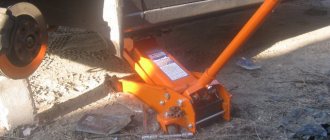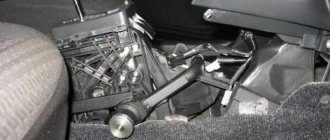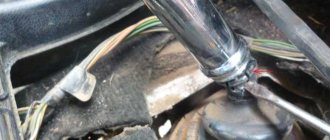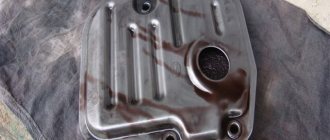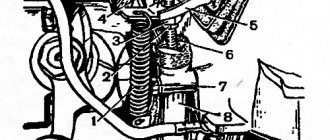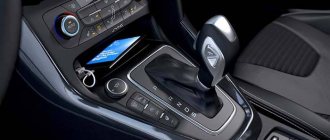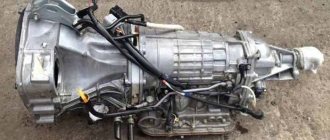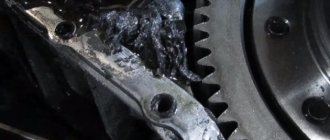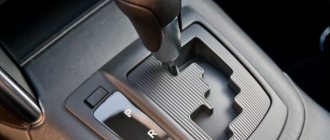Kia Spectra II
The second generation of Kia Spectra was produced from 2004 to 2008. Now they are asking 207 thousand rubles for it on average.
Officially in our country, one engine option was offered with an automatic transmission - 1.6 liters with a capacity of 101 hp. With. The transmission on the Spectrum is the same as that on the Accent, but the performance properties of the transmissions manifest themselves differently. Among the widespread negative reviews of the Spectra automatic transmission is the periodic appearance of vibration and jerking when switching. Planetary gears often howl and clutches wear out. Also, the automatic machine does not tolerate overloads, for example, when towing or using super-heavy trailers.
The Spectra's equipment is at the level of other models in the rating: driver's airbag, electric windows, air conditioning, heated seats and mirrors.
The model is old, so most of the “Spectrum” are sold with a duplicate title, after an accident, with an estimate of repair work and a twisted mileage.
There are models with unpaid fines and a taxi driver's past:
The chance of buying a problem-free car is high. Every third Kia Spectra is sold as “clean”.
Toyota RAV4
Both the Toyota Camry business sedan (seventh place in the ranking) and the Toyota RAV4 crossover are the two most popular cars from Toyota with automatic transmission, they alone account for more than 60% of sales.
The Toyota RAV4 (fourth generation) was generally the leader among Russian crossovers for several years, but now it has been supplanted by the KIA Sportage and Volkswagen Tiguan. Experts say that the reason is simple - the rise in price of Toyota. However, at the end of last year a new, improved model entered the Russian market, which seems to have increased the rating of the Toyota RAV4, at least among owners of an automatic transmission.
Currently, the fifth generation on the Russian market has a 2.0 or 2.5 liter engine, two transmissions - a CVT or an eight-speed hydromechanical - and two drive options (they differ in the number of clutches in the rear wheel drive).
How to distinguish a robot from an automatic or CVT
The fact is that manufacturers strive to simplify as much as possible the entire process of interaction between the driver and the gearbox. For this reason, for example, a robot may have the same selector and modes (PRND) as a CVT or automatic transmission.
As for the driving sensations (provided that the transmission and the car itself are in full working order), you can pay attention to the following:
For this reason, it is recommended to study the vehicle manual separately to determine exactly what type of transmission is installed on a particular model.
In general, pay attention to the following instructions:
- AT - often means hydromechanical automatic;
- CVT - variable speed transmission;
- AMT - robotic gearbox with one clutch;
You can also visit specialized auto forums, study technical literature separately, etc.
Where is the automatic transmission oil dipstick located?
In order to find out exactly where the automatic transmission oil dipstick is located, refer to your car's manual, which necessarily contains information about the location of the transmission oil dipstick. As a rule, such information is located in the “Car Maintenance” section.
Here are some examples in the form of photographs in which we have marked with an orange arrow the location of the transmission oil dipstick in various cars:
Main automatic transmission breakdowns and ways to fix them
Whatever the automatic transmission, it is a technically complex unit, and it is capable of failure. The main “diseases” of Aisin boxes:
The car slips after it warms up, while the “cold” car drives normally.
This is caused by a number of reasons. One of them is a lack of oil in the box. While the car is cold, the oil has increased viscosity and density, the fluid pressure is enough to ensure normal movement. After warming up, the oil becomes more liquid, the pressure decreases, the transmission begins to “glitch”, and the car slips.
In this case, you should simply add gear oil to the Aisin gearbox to the required level.
The second possible reason is contaminated oil. Foreign elements gradually clog the box filter, and the pressure in the system decreases. To solve this problem, you will have to replace the fluid along with the filter.
The third reason is the combustion of the friction disc block.
You should remove the transmission pan, inspect the discs and piston seals, replacing them if necessary.
The box makes extraneous noise, the car does not move, or barely moves, until the oil warms up.
The main reason for this is the failure of the gearbox torque converter. The problem can only be solved by replacing the broken unit.
The car barely moves forward and does not respond to reverse gear. If you try to push the car back, you won't be able to do it.
Such symptoms indicate a breakdown of the planetary gearbox when the sun gear jams. The way to fix the problem is to replace the failed parts or repair them.
The forward gears on the box are engaged, but the reverse gears are not.
Most likely, the brake band of the box is broken and needs to be replaced.
For six-speed gearboxes: 6th gear and reverse are not engaged.
Clutch friction discs are worn. Parts should be replaced.
The transmission gear ratio changes only in the range of 3-5 thousand revolutions, and above.
This behavior is caused by a decrease in oil pressure in the system due to wear on the gearbox gears.
The car has lost its dynamics, the oil pressure in the box is reduced.
This may mean that the box filter is clogged with metal dust from automatic transmission components. The filter and possibly the oil pump should be replaced, since clogging occurs with particles from its gears.
Noise from the automatic transmission at idle.
This means that the automatic transmission torque converter blades are rattling or the discs on the transmission input shaft coupling are worn to the limit. The corresponding units need to be repaired or replaced.
The transmission hit a hard surface, after which the car stopped starting.
You should try to put the box back in its original place if it has moved. If the operation is unsuccessful, you need to adjust the gearbox control rod.
The P position on the box selector is not set.
It is necessary to adjust the automatic transmission drive, diagnose and repair the gearbox locking device.
No transmission brake.
The transmission brake needs to be repaired and the block crown pawl needs to be replaced.
After turning on N on the gearbox selector, the car moves.
The running discs are probably burnt out, or the automatic transmission drive has gone wrong. The box drive should be adjusted or the discs replaced.
The box slips on inclines.
As a rule, this indicates a low oil level; the symptom is eliminated by topping it up.
There is oil on the torque converter housing.
Most likely, the oil pump seal has leaked and should be replaced.
If you don't press the gas, the car rolls back on the slope.
The freewheel is worn out and the part needs to be replaced.
What can damage an automatic transmission?
Most problems with automatic transmissions start from overheating. For example, under heavy load while towing a heavy trailer, or driving through snowdrifts in which the car is slipping. Or if the car is driven for a long time in hot weather. Also, the box may overheat during dynamic sports driving. At high temperatures, the oil in the automatic transmission oxidizes and loses its lubricating properties.
As a result, oily deposits form in the box due to oxidation. If you check the transmission dipstick immediately after it overheats, you will find that the transmission fluid is dark and dirty and has a strong burnt smell.
Also, due to very high temperatures, the rubber seals and O-rings in the automatic transmission become hard and brittle. In addition, the metal parts of the automatic transmission are deformed (for example, transmission valves that regulate the pressure of the transmission fluid in the box).
Sooner or later, these changes in the gearbox will lead to its breakdown.
For example, the Internet often contains stories from car owners who literally burned out their automatic transmissions while trying to get out of the snow or mud while stuck on the road. The worst thing is that this can happen even with a new car, which just recently hit the road for the first time.
However, overheating of the automatic transmission is not the only reason why the transmission may fail. Sometimes an automatic transmission fails due to flaws in its design or due to manufacturing defects. Also, a common cause of automatic transmission failure is its improper maintenance or its complete absence.
Remember that too low an oil level in an automatic transmission, as well as too high, can cause problems with the operation of the box. In particular, if the wrong transmission fluid is used (for example, using gearbox oil that is not recommended by the manufacturer), problems with gear shifting may occur. Also, the wrong automatic transmission oil can lead to complete breakdown of the gearbox.
Volkswagen Tiguan
The reason for the popularity of this brand is its excellent design, solid and at the same time original, good driving performance, spacious interior, spacious trunk and electronic systems inside.
Many experts believe that the Tiguan is a kind of pinnacle of the evolution of class B crossovers. There are two engines to choose from - 1.4 liters and 2.0 liters with a volume of 150 and 180 “horses”, respectively. There are configurations with all-wheel drive and even a special option for the Russian winter - the so-called. Winter Edition with heated seats, snow and ice distance control, three-zone climate control and even a rain sensor. Apparently, the compilers of the package are familiar with Moscow winters firsthand.
The cheapest car with an automatic transmission: TOP-5 rating
So, an automatic transmission greatly simplifies the process of driving a car, since there is simply no need to constantly work with the clutch pedal, as well as correctly select and promptly change gears using the gearbox lever inside the car.
Moreover, if earlier old automatic transmissions noticeably increased fuel consumption, while the car lost dynamics, new automatic transmissions are more or less free of such shortcomings. It should also be noted that in addition to classic automatic transmissions with a torque converter, today there is also an active popularization of robotic gearboxes, as well as CVT variators.
Each of these types of automatic transmissions has both pros and cons, but the main task in the form of fully automatic gear shifting is successfully implemented in each case. Cars with automatic transmissions, robots or CVTs are offered by well-known manufacturers from Europe, South Korea, Japan or the USA, as well as manufacturers from the Russian Federation, Ukraine, Uzbekistan, China, etc.
So, let's return to the budget versions of cars with automatic transmission, which are popular in the CIS; they can be purchased new or whose age, in the case of a used one, does not exceed ten years.
The undisputed leader and at the same time a bestseller on the market was and remains the Daewoo Matiz with an automatic transmission. This compact city runabout can be equipped with a classic 4-speed Jatco automatic transmission; versions with a continuously variable CVT are also occasionally found.
As a rule, it is the hydromechanical automatic transmission that is in great demand due to its maintainability and reliability. Unfortunately, such a car cannot be purchased new, but on the secondary market you can still find versions with minimal mileage in good condition.
Next we can highlight Chery QQ, which also deservedly made it onto the list of the cheapest cars with an automatic transmission. This car is a Chinese “clone” of Daewoo Matiz, and not the most successful one.
First of all, it should be noted that, unlike Matiz, Chery QQ, along with richer equipment and a modernized interior, also received a cheap AMT-type robotic transmission. In practice, such a gearbox is noticeably inferior to classic automatic machines both in terms of reliability and comfort.
The next model in the ranking of the cheapest cars with an automatic transmission is ZAZ Lanos. The car is equipped with a “classic” four-speed automatic transmission and is sold at a very affordable price compared to its competitors.
Also, the version with automatic transmission has power steering, air conditioning, heated seats, power windows and a driver's airbag. The disadvantages include the lack of an ABS system and the outdated exterior/interior of the car.
Next we should mention Ravon R2, which is a new product from Uzbekistan. In fact, Ravon P2 is a slightly modified Chevrolet Spark (Chevrolet Spark).
This car is equipped with a “classic” hydromechanical automatic transmission and can rightfully be considered a full-fledged Daewoo Matiz receiver. As of today, this car remains the cheapest car with a full automatic transmission.
The Citroen C1 model completes the list of the cheapest and most popular cars with an automatic transmission. The car received a good level of equipment, as well as active and passive safety.
The box on this machine is robotic, the robot itself is single-disc. As practice shows, such an automatic robot is more suitable for a calm and leisurely drive around the city.
If the driver practices a more active driving style, then one should expect jerks, jolts and delays when switching. Also, the service life of such a robot is less than that of an automatic transmission or even a CVT, and repairs cannot be called cheap.
How to change the oil in an automatic transmission?
There are two ways to change transmission fluid. The first method of changing the oil is used if the automatic transmission has a drain plug. In this case, the principle of changing the oil is no different from changing the engine oil in the engine.
In some cars, along with changing the automatic transmission oil, you also need to replace a special transmission fluid filter.
What to do if there is no drain plug in the automatic transmission? What to do then? How to drain the transmission fluid and add new oil to the automatic transmission?
To do this, you need to use the second method of changing the oil in an automatic transmission. To do this, you need to unscrew the engine protection from the bottom of the car in order to gain access to the automatic transmission hose through which you can drain the oil.
At the same time, if the automatic transmission has a filter, you also need to unscrew the transmission pan, under which the filter is installed.
In order to completely drain the oil from the automatic transmission, you need to remove the hose that goes to the gearbox. To do this, you need to release the clamp from the hose and remove it from the automatic transmission. Then let the oil drain into the prepared container (1 liter). Then ask an assistant to start the car. Wait until 250 grams of used transmission fluid is poured into the bottle. Next, signal your assistant to turn off the engine. Wait until the bottle is completely filled with oil. Then insert a funnel into the automatic transmission dipstick and fill in exactly as much oil as was drained.
This method is called a partial oil change in the gearbox, since this method does not allow completely replacing the transmission fluid in the automatic transmission.
For those who want to completely change the oil in the box, but there is no drain plug, you will have to contact a technical center, which has special equipment with which you can change the oil in any car equipped with an automatic transmission.
This equipment is connected to the automatic transmission radiator pipe. Next, the engine starts and the old oil begins to drain from the box through one tube and at the same time new oil is poured into the other.
True, this method is very expensive, since the process of changing the oil on such equipment is controlled by a technician using a visual inspection of the color of the transmission fluid in the automatic transmission. As soon as the color of the oil drained from the box turns red, the oil replacement process stops. But with this method, a complete oil change may require twice as much transmission fluid as is required to fill the box.
Robots or need to be careful
The lowest resource of all the machines - to be honest, I don’t recommend buying it! What is a robot - essentially it is a manual gearbox, with a servo drive (or electronic drive) installed on it; it is this that replaces the “clutch pedal” and takes over all shifting functions.
This is the first “weak link” of robotic boxes, these drives are guided by many sensors - engine speed, temperature, speed, etc. – make decisions to switch or stay in this gear. These algorithms are not debugged, they work frankly poorly for almost all manufacturers, and the reliability of servos or electric drives leaves much to be desired - and therefore robots are far from ideal!
Another weak link that directly affects the service life is the “tricky” clutch discs, sometimes there is one, sometimes there are two, such as the DSG from Volkswagen. The reliability of these discs is also low, you have probably heard the scandals associated with these boxes from Volkswagen.
So my advice to you is that if you are buying a new car, you can still consider a robot, but I definitely do not advise you to use a used car, and especially a DSG!
So it’s better to take other transmissions, about them below.
The most reliable automatic transmissions: TOP-10
Description and features of the most reliable automatic transmissions: top 10 automatic transmissions, their characteristics. Video about the reliability of the machine.
It is believed that a manual transmission is more reliable than an automatic one. However, a large number of modern cars are equipped with automatic transmissions due to the ease of operation and other advantages of the latter. Also, among the automatic transmission models, there are at least a dozen that can withstand both difficult operating conditions and the whims of some drivers without significant breakdowns. And even after major repairs they work “like clockwork.” What such devices are is discussed further in the review.
Crossovers - description, advantages and disadvantages
The name comes from the term crossover utility vehicle (also CUV). This means an all-terrain vehicle that combines the main advantages of cars of other classes:
- off-road vehicles (SUV) - cross-country ability, rigid load-bearing body, equipment;
- family cars - spaciousness (including trunk) and comfort;
- urban models - compactness, often relatively low cost.
Representatives of the crossover class are often based on the platform of conventional passenger cars. Geometric cross-country ability, high suspension and sometimes a protective coating on the bottom are “added” to the body. The equipment of such cars usually includes all-wheel drive, automatic transmission, auxiliary road functions and other components.
The vast majority of crossovers are not designed for serious off-road driving. Basically, they are needed in order to safely and conveniently move around the city and highways, sometimes going onto dirt roads, for example, to the country or on vacation.
Advantages of crossovers:
- All-wheel drive available on most models. Of course, this parameter is not the same as that of full-size SUVs, but it greatly helps to overcome difficult sections of the road - from curbs and road defects to obstacles in rough terrain. As a rule, all-wheel drive is activated automatically (if necessary) or at the request of the driver - it is usually not permanent. The benefit of such a system is significant fuel savings in the city and on the highway.
- High driving position. Helps you see the road better, which increases safety and the chance to react to an obstacle. Visibility improves control.
- High ground clearance. Compared to city cars, the ground clearance of crossovers is relatively high. Sometimes the distance to the bottom can be compared to that of SUVs. With this characteristic it is easier to overcome obstacles.
- Geometric cross-country ability. This is a special structure of the body when it does not touch obstacles when the crossover is in a non-horizontal position - pulling out or going uphill, as well as roll.
- Confidence when moving. The attributes of most crossovers - automatic transmission, all-wheel drive, stable heavy body, high seating position and ride quality - ensure safe and stable behavior in any weather and in almost any road conditions.
Disadvantages of crossovers:
- High fuel consumption. The main reason is all-wheel drive, even if it is not permanent. This is also influenced by the vehicle's weight (especially with a lot of passengers and cargo) and the driving style that the crossover allows. For example, a compact city car likely won't find itself in conditions that require high revs or traction.
- Cost of the car. By definition, a crossover is more expensive than passenger cars, and additional funds will be required to equip the model with automatic transmission, all-wheel drive and recommended equipment.
- Service price. Crossovers have a more complex design than compact cars, and are also used in more difficult conditions, which forces them to make repairs and buy components more often.
- Comfort of budget models. Crossovers with good driving characteristics, including automatic transmissions, which are inexpensive - most of them are old models. They may not have very comfortable seats or “cheap” hard plastic upholstery. However, for many drivers, a heated steering wheel and modern options are not as important as all-wheel drive and good cross-country ability.
- Body parameters. Most often, crossovers are noticeably larger than city cars in size. This not only causes problems with maneuverability and compactness, but also higher fuel consumption due to air resistance. In addition, the high ground clearance deprives the crossover of stability on a flat road.
Summarizing the advantages and disadvantages of crossovers, we can understand that they are neither fully SUVs nor city models. It's a versatile vehicle that still doesn't meet every driver's needs in every situation.
GM 5L40-E
Another old but reliable machine. This five-speed automatic transmission was created in 1999 by GM, USA.
It was installed on rear-wheel drive cars with a longitudinal installation of the power unit. Initially, automatic transmission was installed on BMW 323i, 328i models in the E46 body. In 2000, a new version of the transmission was developed, this time for all-wheel drive. And from that moment on, this most reliable automatic transmission was used all over the world - from the BMW X5 to Honda. The automatic transmission could easily handle 420 Nm of torque. This is a durable and very reliable transmission. It easily lasts about 450 thousand kilometers before major repairs.
GM automatic transmission
Abroad, the production of automatic transmissions began in the 40s of the 20th century. The pioneer was the giant of the global automobile industry – General Motors. Currently, the most common transmission is the 6T40. Its mass production was launched in 2008, the unit was designed for light cars. The box itself is compact, weighs 70-90 kg, and offers a large gear range.
A 6-speed transmission was first installed on the Chevrolet Malibu 2.4 in 2008. In the same year, it began to be equipped with Cruze, Daewoo Lacetti and several other cars supplied to the American market. In Chevrolet, the box is most often combined with a 1.8-liter engine. In Europe, the most common models with this transmission are Astra, Meriva. In these cars, it is usually paired with a 1.4-liter supercharged or 1.6-liter naturally aspirated engine. The 6T40 six-speed automatic transmission is still available on new cars.
A typical malfunction of this transmission is the appearance of cracks in the spring ring (has a wavy configuration) of the clutch. Metal shavings along with oil get inside the unit and lead to premature wear of components.
Changing the oil every 60,000 km will help prevent critical damage. This is the only way to see the chips. It is worth noting that the previous GM automatic model with the designation 5L40 (in addition to American cars, was installed on BMW) received high marks from experts in terms of reliability.
KIA Sportage
Since the beginning of 2020, the KIA Sportage has gotten rid of one of its most controversial features - the diesel engine.
Initially, diesel versions were made for European consumers concerned about environmental issues. But it turned out that there are not so many nature-oriented consumers (sales of such cars accounted for no more than 1% of the total volume), and a diesel engine consumes so much diesel fuel that there is no smell of ecology here. Plus it costs a lot. If you wish, you can still have time to grab the old model with a diesel engine. In the meantime, KIA Sportage has returned to its roots and the good old gasoline engines with a capacity of 2.0 and 2.4 liters. Moreover, the 2.4-liter model comes with an automatic transmission and all-wheel drive by default.
Service life of the box - automatic
Let's start right away with the fact that if previously the service life of an automatic transmission was noticeably different from a manual transmission, today the difference is no longer so obvious. On the one hand, the machines themselves have become much more technologically advanced, and on the other hand, over the last 20 years, manufacturers have been consciously putting a certain resource into each unit at the design stage.
This happened due to savings on materials, as well as as a result of the emergence of more powerful and efficient internal combustion engines, which forces the transmission to constantly work in loaded modes.
Other automatic transmission versions
These are the so-called DSG - transmissions with two clutches (widely implemented by VW). The units are designed for high speed - it is ensured by the computer’s readiness to activate the next gear at the right time.
The DSG (Direct Shift Gearbox) is a five-shaft robotic gearbox. The shafts are connected by gears and two clutches. In addition to two clutches, special electronic algorithms are used to change gears. It is this that allows you to minimize switching time, as if preparing the next gear for switching. This is reflected in its second name – “preselective checkpoint”.
An important technical aspect of the DSG is the presence of two primary and two secondary shafts. Each secondary shaft is in mesh with its corresponding primary shaft. Some shafts have even-numbered gears, while others have odd-numbered gears.
There is no doubt that technology will continue to develop. Maybe in a few decades, automatic transmissions will be replaced by more advanced and reliable devices, but for now you need to be serious about choosing a used car with such a transmission, as well as servicing it correctly and in a timely manner. This is the only way to avoid serious technical problems.
How long does an automatic transmission last after repair?
You have repaired the automatic transmission in your vehicle. The next important question for you is to decide what to do - use the car as before, or sell it before new problems and malfunctions arise. Understanding how long the car will travel after repair or what the service life of the repaired gearbox will help you make the right decision.
Even the most advanced computer automatic transmission diagnostics will not give a clear answer to the question of how long a repaired transmission will last. Everything is quite individual and is determined both by the characteristics of operation and the quality of repair work. To understand how long your car will travel after, for example, an Audi automatic transmission repair, you need to take into account the following important criteria:
Place of repair work. If you contacted our company or another specialized car service center, they fixed the faults and gave you a mileage or time guarantee, then you usually don’t need to worry about unforeseen problems. Thus, we value our reputation; our experience and quality of services provided are only increasing. As a result, the return rate after repair is minimal. Therefore, if you choose our services, you will receive high-quality service and a guarantee that your automatic transmission will last at least two years, and in practice this means an even longer period of time.
- Place of repair work. If you contacted our company or another specialized car service center, they fixed the faults and gave you a mileage or time guarantee, then you usually don’t need to worry about unforeseen problems. Thus, we value our reputation; our experience and quality of services provided are only increasing. As a result, the return rate after repair is minimal. Therefore, if you choose our services, you will receive high-quality service and a guarantee that your automatic transmission will last at least two years, and in practice this means an even longer period of time.
- Has the problem really been fixed? This point is directly related to the previous one. If you choose the services of dubious craftsmen or would-be repairmen, you are essentially left without guarantees. If you are far from an expert on the insides of your iron horse, then how can you understand whether you have eliminated the real problem or masked its manifestations, which will return in a couple of months or earlier?
- The quality of the spare parts used. If you are doing automatic transmission repairs from a private owner, and even you know that he is honest and respectable, there is still one problematic issue - the spare parts used in the repair. Such craftsmen do not order original parts, but rely on used spare parts. Hence, repairs are cheaper, but the durability of the repaired box may not be very long. Therefore, in order not to pay twice, or even three times, and not to think about how to quickly sell a problem car, you need to take care of high-quality spare parts.
- Changes in driver psychology. When problems arise with the transmission in a car, after repair work it subconsciously becomes more careful and careful in handling. Therefore, the life of the repaired unit is only extended.
Do you want your car to serve you for more than one year after automatic transmission repair? Then choose the services of professionals who will take care of your car and make it as reliable, efficient and comfortable as when you bought it!
Source
Aisin boxes
Aisin is a Japanese company closely associated with Toyota. It is one of the largest transmission manufacturers in the world. The lineup includes reliable examples, such as the Toyota A-series gearbox: A750 and A760. They have been equipped with SUVs, including Lexus, for the last 10 years. One of Aisin's newest projects is the world's first 8-speed transverse gearbox, AWF8F35, developed in 2013.
The AW 55-50 model (transverse 5-speed transmission with front-wheel drive for the 4x4 version) is equipped in many Opel and Volvo cars. These brands also use models AF33 and FA57. Their weak point is the controller's solenoid valves. The problem is eliminated by replacing the entire module and then adapting the box. In Saab and Opel, owners are faced with oil leaks from coolers.
At the same time, despite the technical similarity, boxes from different models are often incompatible. To preserve engine life and extend service life, experts recommend not accelerating sharply in winter and avoiding frequent oil changes (this should be done after 60,000 kilometers). Although manufacturers set lower limits. Experts also recommend using a lubricant that meets the JWS 3309 standard.
Several dozen brands installed Aisin automatic transmissions in their cars. for most Toyota models. This is the A series, which appeared in the 1950s, the A750/760 is installed on the Toyota Land Cruiser 120, 100 and Hilux, Lexusy IS, GS. The AWF8F35 transmission is equipped with Opel Insignia, Peugeot Rifter, DS 7.
The AW 55-50 “automatic” debuted in 2000 in Volvo cars: 40, 60 and 70. It was also installed in the first generation Kadya (2.5T engine), Renault Laguna II V6, Opel Vectra C and Signum and almost all Volvo models , including XC90 from 2000-03.
What factors affect the service life of an automatic transmission?
The durability of the gearbox depends on timely and competent maintenance. It is necessary, in accordance with the recommendations of the car manufacturer, to change the oil and regularly monitor the condition of the radiator and oil receiver. Proper operation of the automatic transmission implies proper warming up of the working fluids before starting the vehicle. That is why in the winter season you need to pre-heat the box, which takes one or two minutes. This is the only way you can ensure maximum durability of the automatic transmission, and not wonder how long the automatic transmission runs .
Car manufacturers equip their models with both automatic transmissions of their own design and install them under license from the world's leading transmission manufacturers. That is why, when choosing a particular model, it would be useful to read reviews from owners about the reliability of a particular gearbox design. Determine the gearbox installed in your car.
Reliability of Toyota automatic transmission | Myth or reality?
Automatic transmissions from the Toyota manufacturer have proven themselves to be the best. The relatively simple design is combined with durability and excellent maintainability. The service life of a Toyota automatic transmission can be about half a million kilometers. On average, automatic transmissions currently have a mileage of 200–300 thousand kilometers. After this, it is necessary to carry out a major overhaul of the transmission, which allows you to restore its functionality.
Let's sum it up
As you can see, each automatic transmission has both strengths and weaknesses. Also, taking into account the diversity, you may encounter the fact that it can be difficult to immediately determine which automatic transmission is installed on a particular car.
Finally, we note that during operation it is important to separately take into account certain features of a particular machine, depending on the type of transmission and type of automatic transmission. You also need to strictly follow the rules for servicing the automatic transmission, which allows you to increase the resource of the unit.
- The most reliable automatic transmissions
Which automatic transmissions are considered the most reliable: automatic transmission rating with a large margin of safety and a service life of 500 thousand km. and higher. Read more
- The difference between a CVT and an automatic and robot: which gearbox...
What is the difference between a CVT transmission and an automatic transmission or robot transmission: the main differences between CVT and automatic transmission, as well as robotic transmissions such as AMT or DSG. Read more
- Robot or automatic: which type of gearbox is better to choose?
What is better to choose, an automatic transmission with a torque converter or a robotic gearbox with one or two clutches. Pros and cons of these types of boxes, recommendations. Read more
- Automatic transmission: automatic transmission device…
How an automatic transmission works: classic hydromechanical automatic transmission, components, controls, mechanical part. Pros and cons of this type of gearbox. Read more
- Which automatic transmission to choose: what...
What is the difference between a “classic” automatic transmission with a torque converter and a robotic gearbox with one clutch and preselective robots such as DSG. Read more
- Automatic transmission selector: types, purpose and common malfunctions
Automatic transmission selector: basic functions. Types of automatic transmission selectors: steering column, push-button, floor. Malfunction of the automatic transmission selector. Read more
About the producers' conspiracy
Car owners like to say that manufacturers deliberately reduce the service life of automatic transmissions at the factory. Today they no longer produce automatic transmissions that can operate a million kilometers without major repairs. To this must be added the temperature changes in Russia from -40 to +40, as well as the love of car owners for fast driving and cold starts even in winter. Therefore, if in Japan Toyota automatic transmissions are given a service life of 7 years, then on roads in the Russian Federation this period can be cut by exactly half, if not more.
It’s another matter when the manufacturer assures the client that the automatic transmission can be operated without changing the lubricant in it. In fact, no - it's just a marketing ploy. For Volkswagen's DSG gearbox, it is recommended to change the oil every 30,000 kilometers.
All fables about the conspiracy of manufacturers can be avoided if you look into the automatic transmission more often and change the oil and components on time. And proper operation will allow you to extend its life for years.
Reliability and service life of classic automatic transmission
From the previous sentence about a robotic automatic machine, we can already conclude that the service life of a classic automatic transmission will be longer. If only because it does not require frequent replacement of transmission fluid. This suggests that its mechanical components are more reliable.
Read
Typical problems and repairs of automatic transmission f4a42
Attention! An oil change should be done after 60,000, 70,000 kilometers.
If we compare automatic transmission, robot and variator, then neither of the last two can produce as much as the automatic transmission does. The automatic transmission is the standard of reliability. Since it does not have complex mechanical components.
The mechanical clutch function here is performed by the automatic transmission torque converter. Torque from the engine is transmitted to it via ATF.
The oil circulates in the valve body and is distributed through the channels, affecting the actuators or clutches. By applying oil pressure to the clutches, gears are changed. But, recently, clutches began to be produced with an admixture of plastic. This reduced the lifespan of the clutches.
With timely replacement of the oil filter and cleaning of the radiator, the automatic transmission will last a long time. The torque converter is sensitive to the lubricant level. Therefore, it is recommended to monitor the oil level.
Read
Reasons why a car with an automatic transmission does not move forward or backward
The following actions increase the lifespan of an automatic transmission to 500,000 kilometers:
- warming up the machine in winter;
- avoiding slipping on off-road conditions;
- correct towing of a car in case of breakdown.
CVT gearbox and resource of this machine
The CVT transmission (or variator) is the second most reliable. The main difference from automatic transmission is the absence of fixed gear shift stages. But the CVT still uses a torque converter, just like the previous one.
The variator consists of two shafts with pulleys, on which a belt or metal chain is worn. Gear shifting occurs by changing the distance between the pulleys depending on the load on the vehicle. Due to the constant change in the gear ratio, the conditional gears change.
The car owner does not feel constant jerking and jerking when changing gears. Therefore, this box is chosen by those who love a comfortable ride. But the question is how long it lasts.
The service life of the variator is forty percent lower than that of a classic type automatic transmission. It's all about the appearance of chips and dirt in the oil from wearing metal parts. They act on the belt and pulley like an abrasive tool, abrading the surface. As a result, the belt must be changed after driving a car with a CVT for 90,000 kilometers.
Robotic box and its resource
The robotic transmission has a low resource. Since the robot was essentially supposed to become an automated manual transmission. Such a box should have received all the conveniences of an automatic transmission and be as simple as a manual transmission. But this did not happen due to the addition of servomechanisms and an additional clutch unit.
Read
Changing the oil in an automatic transmission Opel Astra J: interval, analogues and materials
There are two types of robot:
- AMT.
- DSG.
AMT
Automated mechanics are servos and actuators that are responsible for shifting gears and clutches. The servo drive is responsible for the latter. He is the unfavorable part of the robot. Before giving a signal to change the gear, the drive must be guided by sensors based on engine speed, temperature and speed.
The relationship between them is not established from the factory. In terms of comfort it is inferior even to an automatic. The car owner constantly feels jolts and jerks when changing gears.
DSG
If AMT is a single-disk robot, then DSG consists of two disks. Volkswagen's DSG belongs to this type. One disk is responsible for even transmissions, the other for odd ones. This type of robot was released to reduce the same shocks and jerks that could not be avoided with the release of the AMT.
Cars with this type of automatic transmission are distinguished by their efficiency, travel comfort, and smooth acceleration. But in terms of lifespan, they are inferior even to a CVT. This type of automatic transmission is enough for 100,000 km. Then the disks and mechatronics (a kind of valve body in the DSG) start to break down, and the software starts to glitch.
